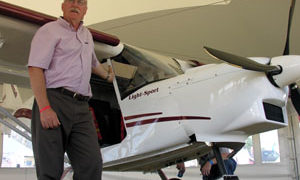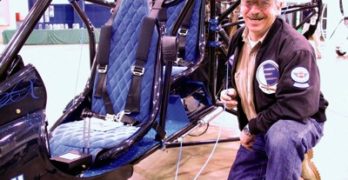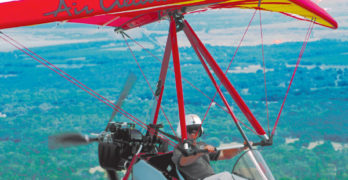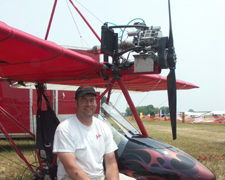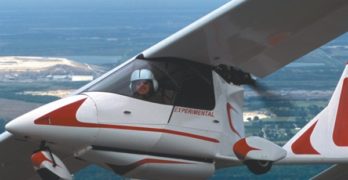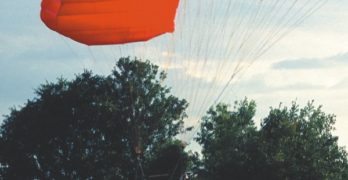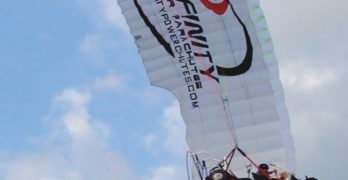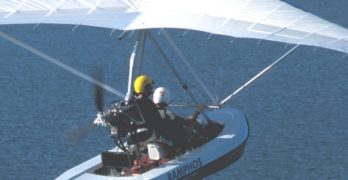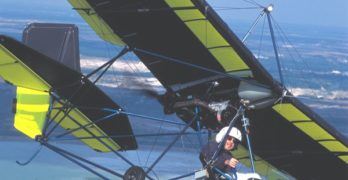The first Canadian company to win SLSA approval was Summit and their powered parachute, itself the first (and still only) such to declare compliance with ASTM standards. Now comes the High River, Alberta-based Savannah (photo). Skykits Corporation president Eric Giles — whom I met at his display at the Arlington Fly-in — called to say he had gained approval for two Savannahs on August 15th, becoming the 39th SLSA. Savannah was created in Italy as a variation of the CH-701 though to many eyes it enjoys a more pleasing appearance. Savannah is available in three models all using the same fuselage but with different wings. The standard Savannah offers fixed, leading-edge slats while the VG model uses vortex generators to increase STOL capabilities. Savannah ADV has a tapered wing featuring electrically operated slats and electrically operated double-slotted flaps with separate ailerons. For those seeking a utility airplane with very short takeoff and landing, Savannah offers a new choice.
Search Results for : electric
Not finding exactly what you expected? Try our advanced search option.
Select a manufacturer to go straight to all our content about that manufacturer.
Select an aircraft model to go straight to all our content about that model.
Hand Control PPC
One innovative designer offers an alternative to foot-controlled powered parachute flight.
For those of you that don’t know, most powered parachutes are steered around the sky using your legs. Pushing with your right leg exerts downward force on a steering line routed to the right trailing edge of the canopy/wing, producing drag on that side and initiating a turn in that direction.
The motion isn’t hard-though some designers have added mechanical advantage to make it easier-and the turn is more responsive that you might imagine. But what if you don’t have good use of your legs? How might you fly a powered parachute?
Canadian powered parachute manufacturer Para-Ski offers a handlebar arrangement, and other companies have experimented with similar ideas. But nearly every other supplier of these flying machines uses a foot-steering arrangement of one kind or another. James Leon of Kankakee, Illinois, has another alternative.
Call It Power Steering
While Para-Ski has its handlebars, a measure of physical effort is still involved.
FK Lightplanes FK-14
Meet the top model from FK Lightplanes.
The frenzy over the FAA’s light-sport aircraft (LSA) and sport pilot proposal continues. Pilots from ultralight to general aviation are discussing it, and the new rule may be released soon, according to those aware of FAA deliberations. We may be about to witness the birth of a new aviation segment. But unlike its predecessors, this one may come with aircraft ready to meet the need. An interesting twist on this American story is that European designs may dominate the first aircraft to fly under the rule, providing they comply with the consensus standards currently being drafted by the community.
This month, let’s meet one of the sleekest, FK Lightplanes’ Polaris FK-14 from Germany.
A Family Business
Peter and Otto Funk are the family members behind the Polaris and its siblings, the high-wing FK-9 (which has gone through three distinct versions) and the folding-wing biplane FK-12.
Air Creation Buggy/Kiss
For many years, I’ve been critical of trike handling. While I try never to forecast the future, I’ve gone out on a limb and predicted that rigid-wings will eventually become commonplace on trikes (though I don’t also predict delta wings will disappear).
Going Rigid?
Rigid-wings look a lot like modern hang gliders and trike wings in many ways, but they have control surfaces. Because these surfaces are deployed via weight-shift movements they neatly combine the benefits of 3-axis ultralights – lower control forces and good control authority – with the elegant simplicity of weight-shift. Rigid-wings can carry good weight and are somewhat faster than delta wings (called “flex wings” by hang glider pilots), and they also handle more easily. I think this makes them a nearly inevitable development.
While I still believe rigid-wings are coming to trikes, it may take longer than I thought because the trike industry may finally be rising to the challenge.
Innovating for Part 103 Ultralights
How can a Part 103 use a four-stroke engine? Well, you can elect the half-VW from Hummel…or you might try a rotary engine as seen at the 2005 Mid-Atlantic Fly-in. This innovative racing cart engine is being developed for Part 103 ultralight use (yes, to make the weight, with electric starter!) by Erik Pederson, the new president of Phantom Aeronautics. Impressively educated, Eric has a BS in Aero Engineering plus an MS and PhD in Mechanical Engineering. Watch for a test report when Erik is satisfied with the performance.
All the Plane You May Want
Over the years, Titan Aircraft has made their Tornado a familiar aircraft seen at flight parks and airports around the nation. Since it was introduced in ’91, the sleek, efficient plane has evolved into a variety of models.
This month we examine the fine work of Roger Bacon who created a lovely red-and-white Tornado II 912, powered by the 100-hp Rotax 912S 4-stroke powerplant expected to be commonplace on light-sport aircraft. Bacon’s airplane is licensed in the Amateur-built category but its facts and figures suggest it could be flown with FAA’s proposed Sport Pilot certificate (until FAA’s new rule is introduced, a private pilot’s certificate or better is required).
Usually I prefer to fly a factory airplane to make sure it correctly represents what a buyer might receive. However, Bacon’s model is so well done, Titan Aircraft encouraged a test flight. Thanks to Bacon for his willingness to let me take his pride and joy aloft.
Hybrid Powered Chute
As focus sharpens on FAA’s proposed Light-Sport Aircraft regulation, the first aircraft segment to complete an ASTM airworthiness consensus standard is powered parachutes. While these aircraft are simpler, which helped speed the process, participating manufacturers got together well and hammered out their certification rules efficiently.
Summit Powered Parachutes of Canada hasn’t yet chosen to enter the Light-Sport Aircraft arena. They aren’t worried, just wary of new regulations. In fact, the company started work under England’s BCAR S regulation. Just recently, Summit was working to qualify for German DHV certification. They see no great challenge passing the proposed U.S. powered parachute standards, as currently defined.
Fortunately, the proposed Light-Sport Aircraft is not the only destination in sport aviation. It may be part of the spectrum of aviation regulations.
We’re seeing more new designs tuned to Part 103. And the Amateur-Built 51% rule will still allow many 2-seat ultralights to be built and flown as they are today.
Infinity Power Parachutes
On a warm summer evening, a large field of 3-foot-tall oats sways gently in the breeze. In this pastoral setting a runway is cut down the middle. The farmer who owns this field has a light aircraft he flies from his country property, and he’s kind enough to allow Tim Norling, a local powered parachute pilot, to use it, too. Norling operates Let’s Fly, an Infinity powered parachute dealer 20 miles north of Minneapolis, Minnesota.
By the time Norling gets his Infinity powered parachute set up, the winds have quieted down, as we hoped they might. It is a beautiful evening for flying in Minnesota, and I am ready for a flight.
Some pilots say, “Oh, those powered parachutes are too vulnerable. You can only fly them in gentle winds.” Yeah, so? Is it really imperative to fly in strong winds? Is being restricted to mild conditions a bad thing?
Powered parachutes tend only to be flown when it’s pleasant to do so.
Italy’s Ramphos Flying Boat
Making a Splash
Last year as the flying season began, an unusual flying boat appeared at airshows. The machine was called Ramphos (pronounced RAM-fohss) and it featured a form of ducted prop surrounding a pair of counter-rotating blades. While these two components commanded a lot of attention, they were de-emphasized when the 2004 season arrived.
In 2003, the presentation was market-savvy. By showing a somewhat radical version of the familiar flying boat design – we’ve seen a few of these configurations over the years – the Ramphos attracted attention in a crowded marketplace. When you’re new (to the American public), you need some way to stand out from the crowd.
However, the downside of new, potentially radical ideas is that people – like me – tend to wait until the new concepts prove themselves. So I didn’t fly the Ramphos in 2003. That changed for 2004.
Modern Machine
For the 2004 flying season, the emphasis had been taken off the counter-rotating props, though it was still displayed and remains an option.
Simple Sprint Pleasures
Excelling at “Just For Fun”
Going back to our roots and the dandy little ultralights that have given in-flight satisfaction to so many, we’re going to take a look at one of those aircraft, Quicksilver’s MX Sprint.
Some veteran pilots call the MX Sprint “humble,” but it is one of those “original” ultralight aircraft that simply won’t go away, and it shouldn’t. Why? Because the Sprint still offers a joyful flying experience that redefines boring holes in the sky. You pilot a Sprint in relative ease and at remarkable low cost, and once price enters the discussion, many ultralights show their value clearly.
Many in light-sport aviation are realizing that aircraft certified Experimental Light-Sport Aircraft (ELSA) and Special Light-Sport Aircraft (SLSAs), even when approved under a simplified, industry-created, ASTM-guided program, will be rather expensive aircraft. Some sleek fiberglass creations are reaching toward the six-figure mark – an unbelievable development given that ultralights have historically traded in a range of $8,000 to $35,000, the latter being a superbly equipped, Rotax 912-powered machine.
- « Previous Page
- 1
- …
- 54
- 55
- 56
- 57
- 58
- …
- 67
- Next Page »


